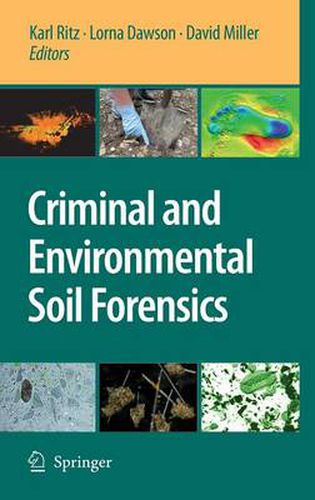Readings Newsletter
Become a Readings Member to make your shopping experience even easier.
Sign in or sign up for free!
You’re not far away from qualifying for FREE standard shipping within Australia
You’ve qualified for FREE standard shipping within Australia
The cart is loading…






This title is printed to order. This book may have been self-published. If so, we cannot guarantee the quality of the content. In the main most books will have gone through the editing process however some may not. We therefore suggest that you be aware of this before ordering this book. If in doubt check either the author or publisher’s details as we are unable to accept any returns unless they are faulty. Please contact us if you have any questions.
Soils have important roles to play in criminal and environmental forensic science. Since the initial concept of using soil in forensic investigations was mooted by Conan Doyle in his Sherlock Holmes stories prior to real-world applications, this branch of forensic science has become increasingly sophisticated and broad. New techniques in chemical, physical, biological, ecological and spatial analysis, coupled with informatics, are being applied to reducing areas of search by investigators, site identification, site comparison and measurement for the eventual use as evidence in court. Soils can provide intelligence, in assisting the determination of the provenance of samples from artifacts, victims or suspects, enabling their linkage to locations or other evidence. They also modulate change in surface or buried cadavers and hence affect the ability to estimate post-mortem or post-burial intervals, and locate clandestine graves. This interdisciplinary volume explores the conceptual and practical interplay of soil and geoforensics across the scientific, investigative and legal fields. Supported by reviews, case-studies from across the world, and reports of original research, it demonstrates the increasing convergence of a wide range of knowledge. It covers conceptual issues, evidence (from recovery to use in court), geoforensics, taphonomy, as well as leading-edge technologies. The application of the resultant soil forensics toolbox is leading to significant advances in improving crime detection, and environmental and national security.
$9.00 standard shipping within Australia
FREE standard shipping within Australia for orders over $100.00
Express & International shipping calculated at checkout
This title is printed to order. This book may have been self-published. If so, we cannot guarantee the quality of the content. In the main most books will have gone through the editing process however some may not. We therefore suggest that you be aware of this before ordering this book. If in doubt check either the author or publisher’s details as we are unable to accept any returns unless they are faulty. Please contact us if you have any questions.
Soils have important roles to play in criminal and environmental forensic science. Since the initial concept of using soil in forensic investigations was mooted by Conan Doyle in his Sherlock Holmes stories prior to real-world applications, this branch of forensic science has become increasingly sophisticated and broad. New techniques in chemical, physical, biological, ecological and spatial analysis, coupled with informatics, are being applied to reducing areas of search by investigators, site identification, site comparison and measurement for the eventual use as evidence in court. Soils can provide intelligence, in assisting the determination of the provenance of samples from artifacts, victims or suspects, enabling their linkage to locations or other evidence. They also modulate change in surface or buried cadavers and hence affect the ability to estimate post-mortem or post-burial intervals, and locate clandestine graves. This interdisciplinary volume explores the conceptual and practical interplay of soil and geoforensics across the scientific, investigative and legal fields. Supported by reviews, case-studies from across the world, and reports of original research, it demonstrates the increasing convergence of a wide range of knowledge. It covers conceptual issues, evidence (from recovery to use in court), geoforensics, taphonomy, as well as leading-edge technologies. The application of the resultant soil forensics toolbox is leading to significant advances in improving crime detection, and environmental and national security.